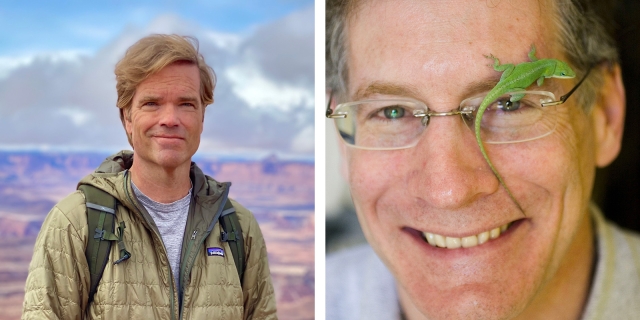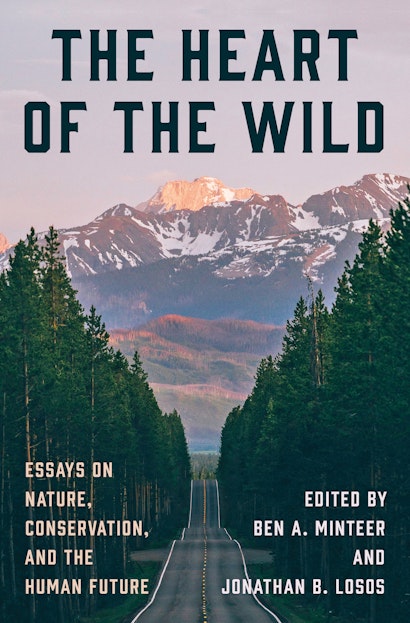The Heart of the Wild brings together some of today’s leading scientists, humanists, and nature writers to offer a thought-provoking meditation on the urgency of learning about and experiencing our wild places in an age of rapidly expanding human impacts.
Why this book, and why now?
BEN: Many conservationists and writers have fallen into a way of thinking about wilderness and “the wild” as profoundly and irreversibly diminished in this “human age.” I’m not one of them, though I recognize it’s getting harder to think of a wild nature that isn’t in some significant way caught in our grip. So I thought it was time to corral a group of distinguished naturalists, nature writers, scientists, and scholars to wrestle with a simple but daunting question: How do we keep a love of nature and the wild alive as we sink more deeply into a human-shaped world?
It was important to me that this be a collaboration. I work on the humanities side of the conversation, and I felt the book needed to be shaped as well by a contemplative scientist, ideally one who was also gauging this fraught moment in our relationship with the natural world. Jonathan Losos, a friend and biologist par excellence, was the obvious choice. And we found some early inspiration in the work and thought of naturalist Harry Greene, didn’t we, Jonathan?
JONATHAN: We certainly did, Ben. I’m one of those conservationists who used to think that our goal was to preserve and restore nature to what it was like before humans came along. But thanks in large part to conversations with Harry and reading his writing, I’ve come to realize not only that in many respects, there’s no turning back the clock—this is truly the Anthropocene Era—but that humans have been interacting with and impacting nature for millions of years: nature has long included us, and we are shaped by it.
The 19th century landscape painter Thomas Cole figures prominently in your book’s introduction and framing. Why this choice, especially for a discussion that is so focused on the future of our relationship to nature and the wild?
BEN: Cole reminds us of the stakes. An English-born artist living in the Northeastern U.S. in the 1830s, Cole produced a remarkable series of paintings depicting a civilization in dramatic decline (The Course of Empire). The work expressed Cole’s deep-seated fear that peril awaits if we stray too far from our wilderness roots. It’s a provocative but also problematic view today, a time in which we’re far more skeptical about the value of wilderness in our hypermodern, tech-laden lives.
We close the introduction by also mentioning Cole’s well-known painting “The Oxbow,” which appeared to suggest a choice to his 19th century audience: Do they really want to clear all the forests, empty the ranges, and drain the marshes (and later, blast the mountains and dam the rivers); to “tame” the land to do their bidding? Or do they want to retain the wild as a vital and formative part of American experience? Alternatively, maybe there was some sort of middle path – a golden mean – falling between these two options?
In many ways, Cole’s challenge is the same one we face today, even as we’ve complicated older notions of wilderness, culture, and the requirements of “the good life.” Cole’s paintings and the ideas behind them therefore seemed to embody many of the concerns and questions we brought to this book, including the friction between different possible answers to his questions. It’s also a reminder, I think, of the perennial nature of American anxieties about environmental impact and decline. But also of hope, and the search for an elusive balance.
Many of the essays in the book challenge traditional goals of conservation in a fast-changing world, especially assumptions about native and non-native species, wild and domestic animals, and so forth. Does this mean backing away from conservation efforts like saving endangered species in their historic habitats?
JONATHAN: No, a central goal of conservation remains preserving as much of the natural world as we can. But what many are now suggesting is that there’s a lot more to nature than endangered species in pristine habitats. As eloquently pointed out by many of the writers in this volume—Crump, Marris, and Shine, for example—the nature that most people interact with is in highly modified environments near human habitations, and most of the species involved are relatively common. Valuing and preserving this aspect of nature is valuable for the species and ecosystems involved, and for the role it plays in getting people to appreciate the natural world.
How we look at introduced species also has become more nuanced. The history of life is one of natural colonizations as species occupy new lands. Still, the rate at which these geographic range expansions are occurring is vastly greater now than in any other time in history. Moreover, in many cases, it is too late— some introduced species are well-entrenched and aren’t going away regardless of what we do, and as a result, resources would be better spent trying to prevent future introductions. Lastly, as I suggest in my chapter on the case of the dingo in Australia, some introduced species may be blaming a positive role in modern ecosystems. In other words, the issue of introduced species isn’t the black-and-white one we used to believe.
One of the book’s core messages is that the future of nature and the wild will depend as much on ethics and emotions as it will science. And yet isn’t there often a tension between these ways of understanding and conserving nature?
BEN: A tension, but not an untraversable gulf. As the old saw goes, science is necessary, but not sufficient. It’s not enough and never has been enough simply to know about rates of biodiversity loss, greenhouse gas concentrations, or accumulating ocean plastic. We need to connect and care about the species, places, and communities being impacted by our activities, near and far. A remark we reference in the introduction by the great conservationist and ecologist Aldo Leopold sums this up with typical power and poignance: “One of the penalties of an ecological education is that one lives alone in a world of wounds.”
For me, this line became a kind of touchstone for the book. In my view, Leopold had it exactly right: a moral, aesthetic, and yes, emotional response to environmental knowledge and awareness is essential. I see this spirit coursing through many of the essays in the book, especially those by natural historians and ecologists such as Tom Fleischner, Marty Crump, Chris Schell, Joel Berger, and Gary Nabhan.
But Jonathan, you’re the scientist here. How do you see this relationship?
JONATHAN: I agree, Ben. Science informs us about how the world works, but it’s up to us to decide what to do with that knowledge, and that’s a matter of ethics and emotion.
The American idea of wilderness has been widely criticized for promoting the myth of a “pristine” nature that inexcusably ignores Indigenous and other cultural histories on the land and doesn’t brook ecological change. How does your book grapple with these criticisms?
BEN: It’s probably one of the more divisive discussions in the collection. For some of our contributors, such as the Indigenous philosopher and environmental justice scholar Kyle Whyte, the historical baggage of “wild concepts” – especially the habit of denying the often violent and tragic cultural history of wilderness places in favor of an unpeopled vision of wild America, is disqualifying. For others, such as the sociologist Eileen Crist, wilderness remains essential to the environmental and conservation movements, an idea and place that needs to be vigorously defended. Writer and philosopher Kathleen Dean Moore takes a different path, suggesting that even if wilderness is still vital, it simply won’t be enough in the conservation strategies of the future. The half-wild, “feral” lands that accommodate and reflect various degrees of human activity should be seen as the significant targets of conservation action in the decades to come.
What do you want readers to take away from this book?
BEN: It’d be great if readers came away from the book more curious about and interested in these ideas and arguments, and in the thoughtful work of our contributors. I also hope readers will see a future in which the best of our conservation and naturalist traditions, especially the love of wild species and places, continues to be carried forward, even as the trail becomes steeper and rockier.
JONATHAN: In addition, I hope that readers have an enhanced appreciation that there’s no one-size-fits-all approach to preserving nature. There are different situations and different perspectives and what may be appropriate in one case may not be in another. Efforts to ensure that our descendants for generations to come experience a biodiverse world will benefit from appreciating this message.
Ben A. Minteer is professor of environmental ethics and conservation at Arizona State University. His books include A Wilder Kingdom: Rethinking Nature in Zoos, Wildlife Parks, and Beyond.
Jonathan B. Losos is the William H. Danforth Distinguished University Professor at Washington University in St. Louis and director of the Living Earth Collaborative. His books include How Evolution Shapes Our Lives: Essays on Biology and Society (Princeton).

